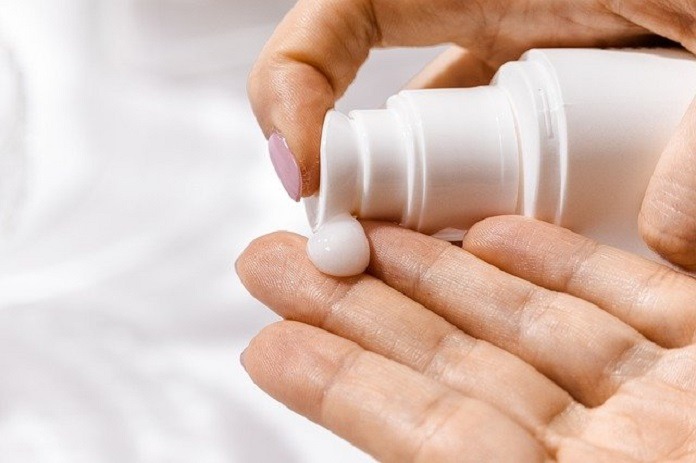Polyhydroxy acids, also known as PHAs, are a type of ingredient that is sometimes used in skincare. What are PHAs in skincare, how do they work, and what are their potential benefits and side effects?
What are PHAs in skincare?
PHAs are small molecules with a specific structure and acidic pH, and they are a recently-discovered type of hydroxy acid that can be added to some skincare products and pharmaceuticals.1 Other types of hydroxy acids used in skincare are alpha-hydroxy acids (AHAs) and beta-hydroxy acids (BHAs). PHAs have a similar chemical structure to AHAs and BHAs; the main difference is that PHAs have several hydroxyl groups on its structure whereas AHAs and BHAs only have one.1 Some commonly-used PHAs include gluconolactone and lactobionic acid.
Hydroxy acids are often used in skincare products and for skin treatments in clinics for chemical exfoliation, which involves gently removing dead skin cells on the very top layer of the epidermis.2,3 This exfoliation may help with some skin concerns for some individuals, and it is often used to treat the signs of mild photoaging and wrinkles.6 However, some people may experience a variety of adverse effects from AHAs, such as skin irritation and increased sensitivity to the sun’s UV rays.4,5
Although PHAs in skincare are less studied than other traditional hydroxy acids such as alpha-hydroxy acids (AHAs) and beta-hydroxy acids (BHAs), some research suggests that they could also be beneficial for a variety of skin concerns.2 For example, one study shows that participants who used either topical AHAs or PHAs for 12 weeks showed similar improvements in many signs of photoaging.7 However, the participants using PHAs reported less burning and stinging sensations than the participants using AHAs.7
The results of this study along with previous research suggest that PHAs may effectively reduce the signs of mild photoaging while having a less severe side effect profile than AHAs; however, more research is needed to validate this claim. However, since PHAs often have higher molecular weights than AHAs, they may cross the epidermis more slowly due, in part, to their larger size. This, in turn, could theoretically lead to less irritation; however, more research is needed.8
Additionally, although AHA use may be associated with increased photosensitivity, some evidence suggests that PHAs may actually help protect against the sun’s harmful UV rays.5,8 One study found that the PHA gluconolactone helped protect skin cells from UV radiation in vitro.8 More research is needed to further investigate whether gluconolactone and other PHAs can have a photoprotective effect on the skin.
Many PHAs can also act as antioxidants; this means that they work to neutralize free radicals and in turn reduce their potentially damaging and aging effects.9 More research is needed to determine how this works, and whether or not this antioxidant property in PHAs plays a role in preventing or reducing the signs of photoaging.
How do polyhydroxy acids work?
The exact mechanism of how PHAs work is not fully known, as they are not as well-studied as earlier-discovered hydroxy acids, such as AHAs and BHAs that are present in certain skincare products. However, some early research on the effect of PHAs on skin cells suggests that they may function as a type of chelating agent.1 A chelating agent, in regards to skincare, helps bind to metal particles and prevents them from binding to surfaces and contaminating products. Its antioxidant properties may also play a role in its potential benefits; however, more research is needed.
What are the side effects?
Some common side effects of PHAs may include mild stinging, burning, and skin irritation.7 PHAs are considered to have a relatively mild side effect profile; however, it is important to seek medical help if you experience any side effects that you are concerned about when using skincare products that contain PHAs. Additionally, seek medical help immediately if you experience signs of an allergic reaction after using topical PHAs, such as chest tightness, hives, or swelling of the face, mouth, or throat.
Despite the potential photoprotective effects of PHAs, it is still essential to protect yourself from UV radiation. This can be done through limiting sun exposure, wearing sun-protective clothing, and regularly applying a broad-spectrum sunscreen that protects against both UVA and UVB radiation.
This article is not medical advice, and it is not intended to prescribe, diagnose, or promote specific treatments for any condition. Consult your doctor, dermatologist, or other qualified healthcare provider for your unique skincare needs.
References
- Kornhauser, A., Coelho, S.G., Hearing, V.J. (2010, November). Applications of hydroxy acids: classification, mechanisms, and photoactivity. Clin Cosmet Investig Dermatol 3:135-142. Doi: 10.2147/CCID.S9042
- Grimes, P.E., Green, B.A., Wildnauer, R.H., Edison, B.L. The use of polyhydroxy acids (PHAs) in photoaged skin. Cutis 73(2 suppl): 3-13. Accessed 2021, June 16, from https://europepmc.org/article/med/15002656
- Ladenheim, L.A., Marmur, E.S. (2021). Cosmeceuticals using Alpha, Beta, and Polyhydroxy Acids. Cosmeceuticals. Aesthet Dermatol 5: 20-25. Doi: 10.1159/000491842
- Lee, J.Y., Park, C.W., Lee, C.H. Cutaneous Irritation due to repeated topical application of alpha hydroxy acid. Korean J Dermatol 38(12): 1598-1602. Accessed 2021, June 17, from https://www.koreamed.org/SearchBasic.php?RID=2146464
- Kaidbey, K., Sutherland, B., Bennett, P., et al (2003, February). Topical glycolic acid enhances photodamage by ultraviolet light. Photodermatol Photoimmunol Photomed 19(1): 21-27. Doi: 10.1034/j.1600-0781.2003.00013.x
- Ditre, C.M., et al (1996). Effects of alpha-hydroxy acids on photoaged skin: a pilot clinical, histologic, and ultrastructural study. J Am Acad Dermatol 34.
- Edison, B.L., Green, B.A., Wildnauer, R.H., Sigler, M.L. (2004). A polyhydroxy acid skin care regimen provides antiaging effects comparable to the alpha-hydroxyacid regimen. Cutis 73(suppl 2): 14-17. Accessed 2021, June 17, from http://beauty-review.nl/wp-content/uploads/2015/06/A-polyhydroxy-acid-skin-care-regimen-provides-antiaging-effects-comparable-to-an-alpha-hydroxy-acid-regimen.pdf
- Bernstein, E.F., Brown, D.B., Schwartz, M.D., et al (2004, February). The polyhydroxy acid gluconolactone protects against ultraviolet radiation in an in-vitro model of cutaneous photoaging. Dermatologic Surgery 30(2): 189-196. Doi: 10.1111/j.1524-4725.2004.30060.x
- Audina, M. (2021). A review on anti-aging properties of polyhydroxy acid. World Journal of Pharmaceutical Research 10: 137-141. Accessed 2021, June 17, from http://repository.ubaya.ac.id/38988/
- Image by AdoreBeautyNZ from Pixabay



